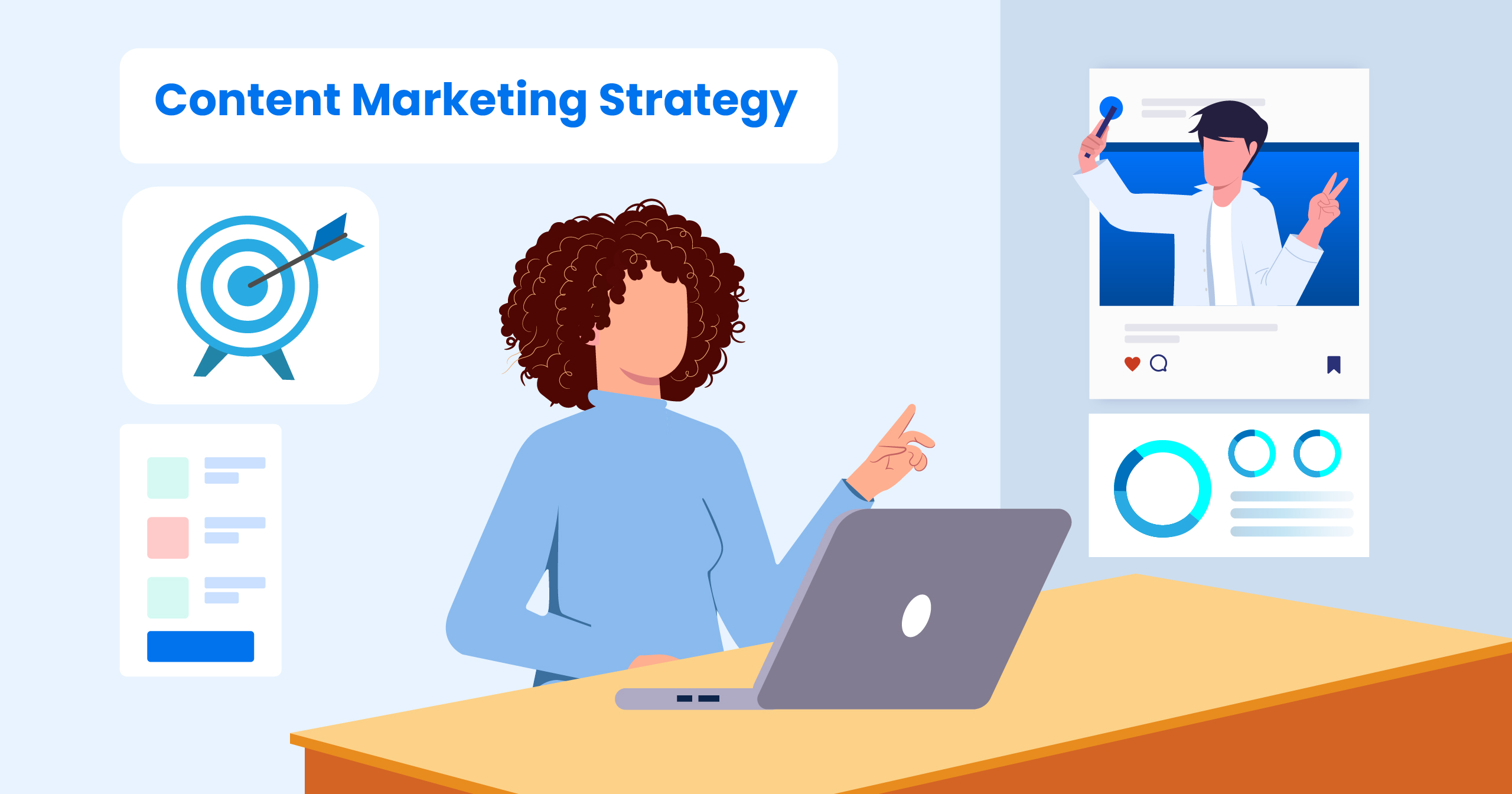In today’s digital landscape, the power of content marketing is undeniable. But are you truly leveraging its full potential? Many startups and content marketers grapple with this challenge, often struggling to create impactful content that resonates with their audience and drives action. The solution? A well-crafted content marketing strategy.
This approach not only helps you connect with your audience on a deeper level but also propels your brand towards success. This article will serve as your roadmap, helping you transform your content from mere words into a powerful tool for growth.
What Is Content Marketing?
Content marketing is a strategic marketing approach that involves creating content and distributing valuable and relevant content to attract, engage, and retain a specific target audience.
It is focused on providing information, entertainment, or educational value to the audience rather than directly promoting a product or service. The content can take various forms such as blog posts, articles, videos, infographics, podcasts, social media posts, and more.
By delivering high-quality content that addresses the needs, challenges, and interests of the target audience, businesses aim to attract and engage potential customers. This approach allows them to connect with their audience deeper, foster trust, and position themselves as valuable resources in their industry.
Content marketing is a long-term strategy that requires consistent content creation and distribution of content, along with effective promotion and optimization. By providing valuable content, businesses can build relationships, enhance their brand reputation, and ultimately drive customer loyalty and conversions.
Why Is Having A Content Marketing Strategy Important For Startups?
In the competitive world of startups, it is crucial to establish yourself as a trusted authority in order to stand out from the rest. To create a content marketing plan, startups can strategically position themselves as experts in their field.
A documented content marketing strategy enables startups to effectively showcase their knowledge, insights, and unique value proposition through valuable and targeted content marketing campaigns. It allows them to:
- Share valuable insights: Startups can benefit by focusing on providing valuable insights and information related to their industry. This can include sharing industry trends, market analysis, research findings, and practical advice to benefit their audience. By offering unique perspectives and useful information, startups can establish themselves as innovators.
- Demonstrate expertise: Startups can showcase their knowledge and expertise in their respective fields. This can be done through creating high-quality content such as blog posts, whitepapers, case studies, and videos that highlight their expertise. By consistently delivering valuable and accurate information, startups can build credibility and gain the trust of their audience.
- Engage with the audience: Actively engaging with the audience is crucial for establishing trust and building credibility. Startups can encourage feedback, respond to comments and questions, and participate in relevant discussions. This demonstrates their commitment to engaging with their audience and shows that they value their opinions and concerns.
- Be consistent: Consistency is key when it comes to thought leadership. The aim for Startups is to develop a content strategy and consistently produce high-quality content that aligns with their target audience’s interests and needs. By maintaining a regular publishing schedule, startups can build momentum and stay on the radar of their audience.
- Collaborate with industry peers: Building relationships with other industry leaders and influencers can significantly enhance a startup’s credibility. By collaborating on projects, co-authoring content, or participating in industry events together, startups can tap into the expertise and reputation of others to strengthen their own thought leadership position.
- Leverage social media and online platforms: Founders can utilize social media and other online platforms to amplify their thought leadership efforts. Sharing content, engaging with followers, participating in relevant industry groups, and utilizing platforms like LinkedIn, Twitter, and industry-specific forums can help startups reach a wider audience and gain visibility as thought leaders.
- Seek speaking opportunities: Actively seeking speaking opportunities at industry conferences, webinars, and events can enhance a startup’s credibility and visibility. Presenting on topics relevant to their industry and sharing their expertise in front of a live audience can establish them as knowledgeable and authoritative figures within their field.
- Showcase success stories: Sharing success stories and case studies highlighting the startup’s achievements can further strengthen its thought leadership position. By demonstrating tangible results and showcasing how their expertise has led to positive outcomes, startups can build trust and inspire confidence in their audience.
- Stay up-to-date with industry trends: Thought leaders need to stay informed about the latest developments and trends in their industry. By staying ahead of the curve, startups can offer fresh insights and perspectives, further establishing themselves as thought leaders.
- Be authentic and transparent: Lastly, by sharing both successes and failures, being transparent about their processes and methodologies, and admitting when they don’t have all the answers, startups can foster a genuine connection with their audience.
A documented content marketing strategy is an essential tool for startups to effectively plan, execute, and measure their content marketing efforts. By outlining goals, target audience, content types, distribution channels, and key performance indicators (KPIs), this strategy provides startups with a roadmap for success.
Some Content Marketing Facts
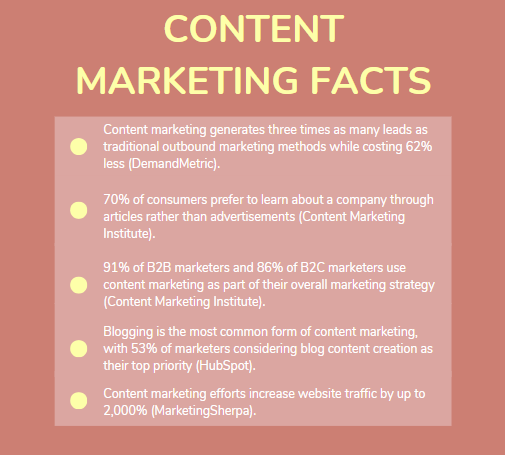
The Three Foundational Steps For Your Marketing Strategy
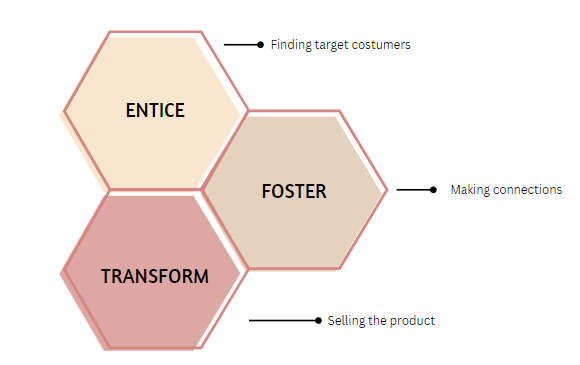
These 3 steps are the foundation of your marketing strategy, providing a structured roadmap for all your marketing endeavors.
Here’s how it works:
Step 1 – Entice: Captivating The Attention And Building Personal Connections
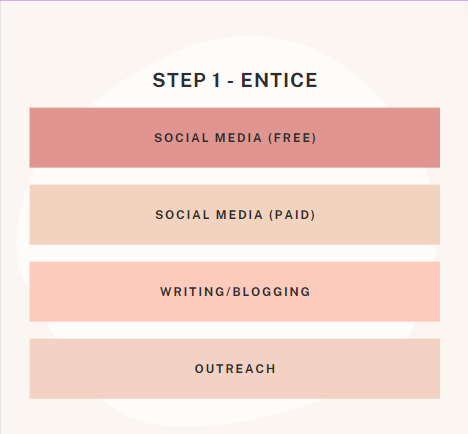
During the “Entice” step, the goal is to actively capture the attention and interest of potential customers. It’s like waving a flashy sign that says, “Hey, come check out what we’ve got!” To achieve this, you must embrace a personalized approach and cultivate an environment where customers feel genuinely welcomed.
By optimizing efforts in creating content and tailoring the content creation process to customer needs, you can break through the noise and create content that has a lasting impact.
Creating a sense of belonging and forging personal connections not only fosters customer loyalty but also increases the likelihood of turning them into satisfied brand advocates. It’s about going beyond transactional interactions and creating that special connection that resonates deeper.
There are numerous strategies that one can implement to achieve this, and I’ll discuss a few key ones here:
Social Media (Free):
Have you followed a Facebook page simply because you enjoy their posts? It could be a comedy page, or perhaps something related to politics. Regardless of the topic, the content they share has caught your attention.
That’s precisely how you can leverage social media during the Entice step. You can utilize platforms like Facebook to attract potential customers or connect with individuals on Twitter. Why not explore the power of releasing engaging videos on YouTube? Another option could be writing compelling posts on different blogging websites.
The goal is to leverage the power of social media platforms to connect with your target audience. Share engaging content, interact with potential customers, and build a community around your brand. It’s a cost-effective way to attract attention and create a buzz for your startup.
Primary Objective
The primary objective at this stage is not to make an immediate sale. Instead, focus on building an audience. By doing so, you’re setting the stage to eventually convert that audience into revenue.
| Pro: Social media platforms offer a cost-effective solution to connect with vast audiences. Con: It can be time-consuming to manage and maintain a strong social media presence. |
Social Media (Paid):
Social media paid advertising involves investing money to promote content, ads, or campaigns on platforms like Facebook, Instagram, LinkedIn, Twitter, or YouTube.
Advertisers can target specific audiences based on demographics, interests, and behaviors, creating visually appealing ads with persuasive copy and call to action. By setting a budget and participating in ad auctions, businesses can secure ad placements. They can track and optimize ad performance using analytics provided by the platforms.
Social media paid advertising allows businesses to reach a targeted audience, increase brand visibility, and drive desired actions. Yes, it requires a financial investment, but it can save you significant time and effort. You even have the option to hire professionals who specialize in writing, managing, and optimizing these ads for you.
By entrusting content marketing tactics and task management to professionals, you can save valuable time and concentrate on essential aspects of managing your startup.
Primary Objective
However, it’s important to remember that, at this stage, your primary goal is to build your audience. Utilize ads during the Entice step to drive traffic to your website, encourage people to read your blog, or entice them to join your Facebook page.
| Pro: Convenient. Trackable through analytics. Requires minimal effort on your part. Con: Can be costly. |
Writing/Blogging:
Ever been told, “Every startup needs a blog!”? It’s a common claim, but I will challenge that notion. The truth is, you only need a blog if it aligns with your overall marketing strategy. Starting a blog simply because everyone else has one may not be the right move for your startup.
However, let’s not overlook the potential benefits of a well-crafted, high-quality blog. It can be a powerful tool to build an audience and provide immense value to your readers.
By targeting your blog content toward your ideal customer, you attract individuals who will most likely become buyers of your product or service.
Moreover, a well-optimized blog can also drive significant traffic from organic search, further amplifying the reach and impact of your own content marketing strategy.
Primary Objective
Your aim here is to establish yourself as an industry expert by creating valuable content through writing and blogging. Share your expertise, wisdom, and valuable insights with your audience. This not only helps attract potential customers but also builds trust and credibility for your startup.
Some of the top blogging websites are:
| Pros: Complete control over your platform and content. Offers opportunities for monetization and revenue generation. Cons: Requires a significant investment of time and effort. Building momentum and gaining traction can be challenging. |
Outreach:
Outreach is a proactive approach where startups take action to reach out to their ideal customers. Instead of waiting for customers to come to them, startups actively engage with potential customers. This allows them to initiate conversations and gain a better understanding of customer needs.
Outreach methods include handing out brochures, making phone calls, and reaching out on social media. These channels provide opportunities to connect with potential customers and have meaningful discussions.
- Handing out brochures or promotional materials is a way to catch the attention of interested individuals. It creates a tangible presence and leaves a lasting impression. Face-to-face interactions during brochure distribution allow startups to answer questions, address concerns, and build rapport.
- Making phone calls offers a direct and personal approach to connecting with individuals. Startups can introduce themselves, explain their offerings, and actively listen to customer needs and preferences. These conversations provide valuable insights for product development and marketing strategies.
Primary Objective
During this step, you aim to proactively engage with individuals or organizations that align with your target market. One way to gather information about your audience is by utilizing tools such as Market Explorer.
These outreach efforts can help you expand your reach and attract new prospects to your startup. While outreach may not be the most popular tactic of the Entice step, as it can be associated with sales and cold calling, it can yield remarkable results if you’re willing to invest the effort.
| Pros: Instantly establish a connection with your target customers, fostering a more personal relationship. Cons: Outreach can be extremely time-consuming and challenging to consistently maintain a genuine approach. |
Step 2 – Foster: Building Relationships And Guiding The Audience
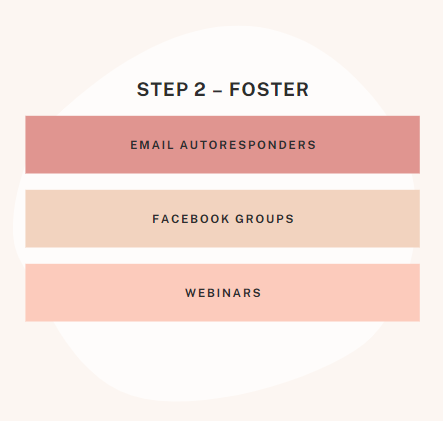
Alright, you’ve successfully established an online presence and captured the attention of your target customers. Now, it’s time to shift the focus towards fostering the audience and guiding them towards a potential sale. This step is all about offering more specific information that directly addresses the problems your product solves.
For instance, if your startup has a new widget, you can create an email series that showcases how it can solve your audience’s unique challenges.
Remember, it’s crucial to collect contact information from your audience, such as their email addresses. Not only are you guiding your audience towards a purchase, but you also have a direct means of contacting them when the time is right.
Let’s dive into some effective tactics that you can use to foster the audience:
Email Autoresponders:
An autoresponder is an invaluable tool that enables startups to automate the delivery of a carefully crafted sequence of emails. With an autoresponder, once you have written and set up the emails, the software takes over the responsibility of sending them to your customers at predetermined intervals or in response to specific triggers.
This automation not only saves you time and effort but also ensures consistent and timely communication with your customers. By designing a well-planned email sequence, you can deliver relevant and engaging content that guides your customers through their journey with your brand. Each email in the sequence can be strategically crafted to provide valuable information, address customer pain points, showcase your products or services, and nurture the relationship.
This approach keeps your brand prominent as you connect with potential customers. Additionally, leveraging user-generated content can further enhance the authenticity and engagement of your content marketing strategies.
Let’s consider a couple of examples:
- If you’re a small law firm, you could create a five-email series titled “Free Email Course Teaches YOU How to Prepare Your Will.” This educational series would provide valuable information and guidance to your audience.
- Alternatively, if you’re a used game reseller, you might offer a regular newsletter with the enticing headline “Receive Video Game News and Reviews, Right to Your Inbox!” This strategy ensures that your audience stays engaged and well-informed about the latest developments in the gaming world, keeping them hooked and eager for more.
Primary Objective
By implementing autoresponders, you aim to transform an occasional audience into an engaged one.
This marks the beginning of the foster step, where you establish a line of communication with your subscribers. Over time, you can smoothly transition into the transformation step by including an email offering a tempting incentive like “Receive 10% off your next video game.”
Here is an expanded list of top email autoresponder tools:
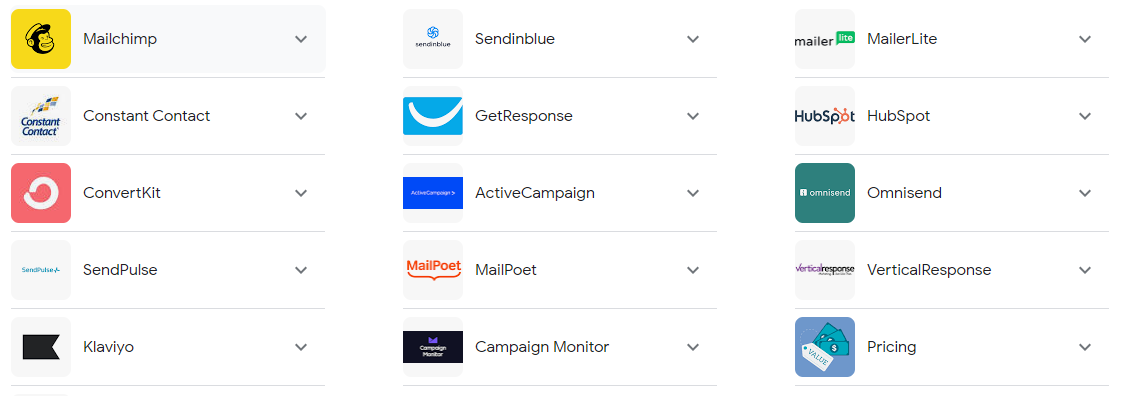
These tools offer various features and pricing plans, so it’s recommended to visit their respective websites and compare them to choose the one that best fits your specific requirements.
| Pros: Free. Highly-targeted. Easy to monetize. Cons: Time-consuming. Hard to come up with new ideas (for a newsletter). Expensive if you hire a writer (education series). |
Facebook Groups:
Facebook Groups offer startups a compelling opportunity to connect with their target customers in a virtual hangout spot. These groups provide a platform for real conversations, personalized advice, and valuable feedback on products or services.
The beauty of Facebook Groups lies in creating a community of individuals who share a genuine interest in what the startup has to offer. Startups can foster meaningful interactions by actively engaging with group members, initiating discussions, and providing valuable insights.
Benefits Of Facebook Groups For Startups:
- Personalized Advice: Within Facebook Groups, startups can offer personalized advice to members based on their specific needs and challenges. This personalized approach helps build trust and establishes the startup as a reliable source of information and support. By addressing individual concerns and providing tailored guidance, startups can strengthen relationships with their target customers.
- Valuable Feedback: Facebook Groups encourage members to share their experiences, opinions, and suggestions, providing startups with valuable feedback. This feedback can offer insights for improving products, services, or overall customer experience. By actively listening and engaging with group members, startups can gain valuable insights and make necessary adjustments.
- Market Research: Facebook Groups offer startups a unique opportunity to gather valuable market research. By actively participating in discussions, startups can gain a deeper understanding of their target audience’s preferences, pain points, and aspirations. This knowledge can then be used to refine marketing strategies, develop new offerings, or enhance existing ones.
- Relationship Building: Engaging with members in Facebook Groups allows startups to build relationships and establish a strong presence. By consistently providing valuable content, initiating discussions, and being responsive to group members, startups can foster trust and loyalty within the community. This can lead to brand advocacy, word-of-mouth recommendations, and long-term customer relationships.
- Promotion and Visibility: Facebook Groups let startups stay on their target customers’ radar. Regular engagement, sharing updates, and providing value allow startups to establish their brand presence. When the time is right, startups can leverage this visibility to introduce well-placed offers or promotions, generating interest and potential conversions.
Startup: “GreenTech Innovations”
Facebook Group: “Sustainable Living Enthusiasts”
Scenario: A member of the “Sustainable Living Enthusiasts” Facebook group, named Sarah, posts a question about how to reduce her home’s carbon footprint. She mentions that she’s particularly interested in renewable energy solutions, but she’s unsure about the costs and feasibility for her small suburban home.
GreenTech Innovations, a startup specializing in affordable and sustainable energy solutions, sees Sarah’s post and responds:
“Hi Sarah, we appreciate your interest in reducing your home’s carbon footprint! At GreenTech Innovations, we specialize in providing affordable and sustainable energy solutions. For a small suburban home like yours, we would recommend considering solar panels.
They’re a great way to harness renewable energy and can be more cost-effective than you might think. We’d be happy to provide a free consultation to discuss your specific needs and help you understand the potential costs and benefits. Please feel free to DM us if you’re interested!”
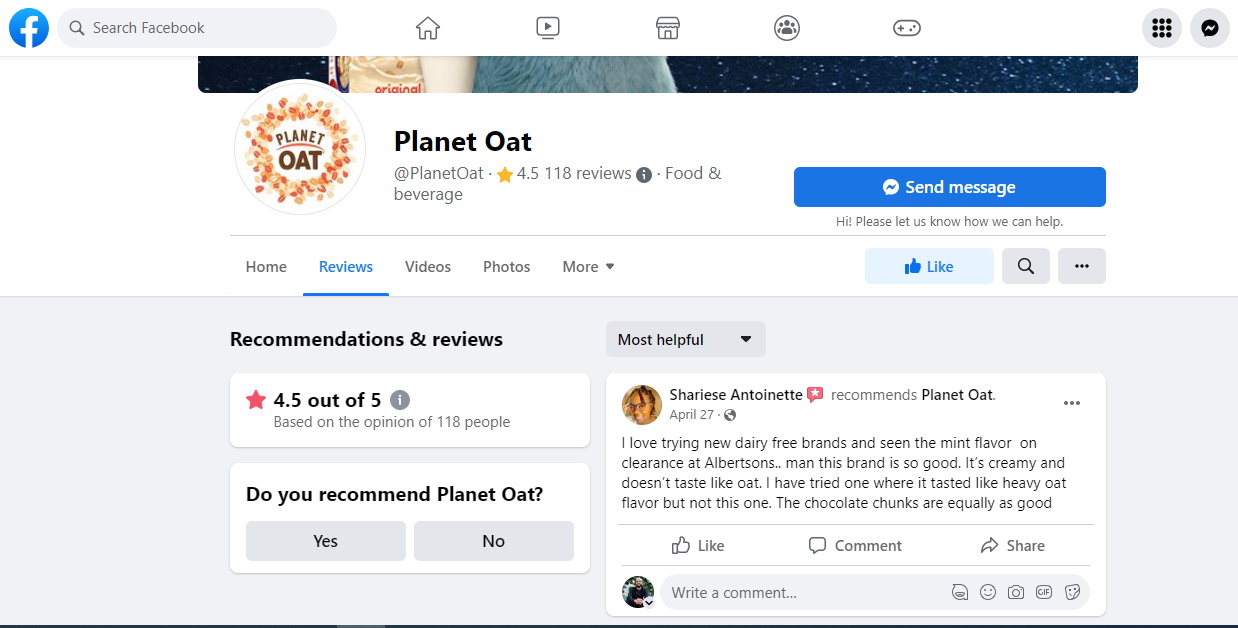
Primary Objective
Your target here would be to create a community where you can engage with your audience, provide valuable insights, and foster a sense of belonging. This platform allows you to interact directly with your audience, address their concerns, and showcase the value of your product.
| Pros: Cost-free. Highly personalized. Ideal for niche experts (fitness trainers, mentors, artists). Cons: Difficult to outsource to others: they specifically seek your expertise. |
Webinars:
Webinars offer startups a dynamic platform to engage their audience, share valuable insights, and establish thought leadership. These live online events allow startups to interact directly with their target customers, fostering a sense of connection and trust.
To create a content marketing strategy centered around webinars, startups need to plan effectively and promote their events. This involves identifying relevant topics that align with their target audience’s interests. By addressing these specific areas of interest, startups can demonstrate their expertise and position themselves as trusted authorities in their industry.
During the webinar, startups have the opportunity to deliver compelling presentations, utilizing visual aids, storytelling techniques, and interactive elements to captivate their audience. They can share in-depth information, offer practical advice, and provide valuable takeaways that address the challenges faced by their potential customers.
Primary Objective
The ultimate goal is to provide unique and valuable information, captivate attendees, and achieve specific outcomes aligned with the host’s objectives, such as enhancing brand visibility, driving conversions, or building a dedicated community.
Webinars are a natural way to transition to the next step—transformation. It’s a powerful way to generate leads and turn prospects into paying customers. Following are some widely used webinar software:
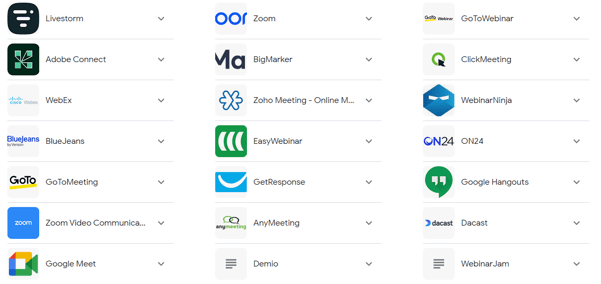
| Pros: Free. Very personal. Cons: Requires video equipment/technical knowledge. |
Step 3 – Transform: Sealing The Deal And Maximizing Sales
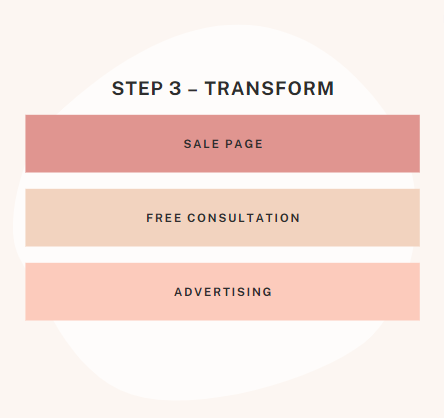
It’s time to ask for the sale and watch the money flow into your startup. But hey, don’t stress, because sealing the deal is actually pretty straightforward.
All you need to do is make your offer and tell your customers how your startup’s product or service can solve their problems. It’s like presenting them with the perfect solution on a silver platter, with your brand name shining brightly.
So, how can you, as startup founders, seal the deal and maximize your sales? Here are several strategies worth considering:
Sale Page:
At this critical point in your content marketing strategy, your audience has reached the end of your engaging email series, and now it’s time to make that final push toward a sale. Instead of directly asking for the sale in the email, why not lead them to a dedicated sales page that speaks directly to their desires, leveraging effective content marketing strategies?
Imagine this scenario: In your last email, you entice readers with a compelling offer like “Click here and get a professionally written will in just three days!” When they click the link, they land on a persuasive sales page highlighting the benefits of your easy estate planning service.
The page showcases your expertise and emphasizes the convenience of scheduling a visit to your firm.
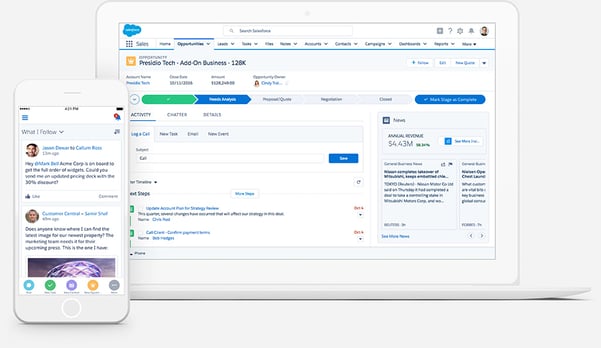
Image source: SalesForce
Primary Objective
The aim is to create an enticing sales page that showcases the unique value of your offering and convinces customers to take action. Highlight the benefits and features that set your product or service apart from the competition, and present a compelling call-to-action that encourages customers to make a purchase.
This approach has proven to be highly effective. The beauty of these pages is that you can continually refine and enhance them to maximize conversions.
| Pros: Customizable. Great final step. Trackable (Google Analytics). Cons: Can be costly. |
Free Consultation:
Now, let’s change things up a bit. If you’re more into picking up the phone and closing deals with a personal touch, I’ve got a different approach for you. Forget about those fancy sales pages for now and instead, offer your potential customers a free consultation. It’s like having a friendly chat where you can address any concerns they may have and ensure that your product or service is a perfect fit for them.
Imagine this: You dial their number, have a genuine conversation, and really understand their needs. It’s your chance to answer their questions, ease any doubts they might have, and show them why your offering is exactly what they need. By taking the time to connect one-on-one, you can build trust and create a tailored solution that meets their unique requirements.
Free consultations are all about that personal touch and going the extra mile to understand your customer’s specific situation. With that direct interaction, it becomes easier to address objections, demonstrate the value you bring, and ultimately seal the deal.
Primary Objective
In this step you will focus on offering a free consultation where you can personally connect with potential buyers, address their specific needs, and demonstrate the value of your solution.
| Pros: Can be more persuasive. Cons: Time-consuming. Budget-consuming (paying a sales team). |
Advertising:
As startup founders, you can effectively reach your ideal customers and capture their attention by employing targeted advertising. Leverage platforms such as social media, search engines, and display ads to showcase your irresistible offer to a highly relevant audience.
Create captivating ad copy and visually appealing content that highlights the unique selling points of your startup. This will entice customers to click through and make a purchase.
During the transformation step, you’ll notice a significant change in the appearance of your ads compared to the initial entice phase.
In the Entice step, your ads were:
- Broadly targeted
- Focused on attracting people to your target
However, in the transformation step, your ads take on a different approach:
- Highly specific in targeting
- Geared towards motivating people to make a purchase
Primary Objective
In this step, you focus on engaging with individuals who are already familiar with your brand and understand the value your product brings to their lives. And there are several effective strategies we can employ to accomplish this. One of my personal favorites is retargeting, which involves displaying ads to people who have previously visited your website. It’s like reconnecting with them and saying, “Hey, remember us? We’ve got something amazing just for you!”
If you’re seeking improved advertising avenues, this article could provide valuable assistance.
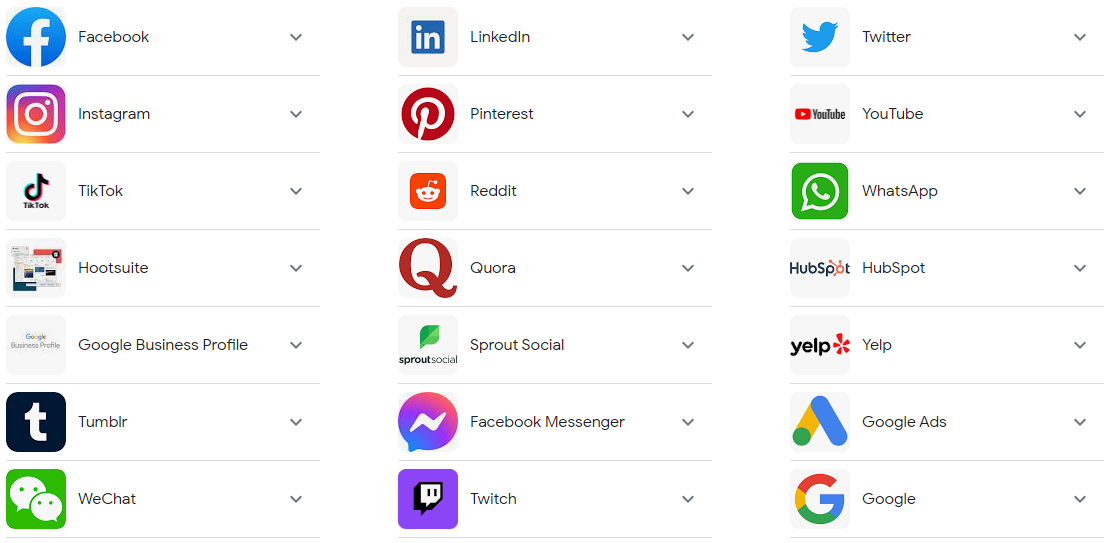
| Pros: Easy. Trackable. Automated. Cons: Costly. |
Content Marketing Strategy In Action
A successful content strategy can be the pivotal driving force for your startup’s success. Let’s discover how you can set this content marketing strategy in motion, using a practical example for a comprehensive understanding.

The Company: FitFuel short for FreshBite Meal Prep
The Product: Pre-packaged, healthy and convenient meal plans
Target Customer: Busy professionals and health-conscious individuals who want nutritious meals without the hassle of cooking
Entice:
FitFuel knows how to make your taste buds tingle! They’re always posting mouthwatering food pics on Instagram, along with easy recipes and wellness tips. They even team up with fitness gurus to give you exclusive discounts and freebies on their tasty and healthy meals.
- Engaging social media content (images, videos, captions)
- Valuable information, tips, and discounts
- Collaborate with influencers
- Showcase unique features and benefits
Foster:
Hey, want to “Nourish Your Body” like a pro? Join FitFuel’s newsletter gang! Every week, they’ll hook you up with personalized meal recommendations, insider nutrition and fitness advice, and secret recipes you won’t find anywhere else. Oh, and they love sharing inspiring stories from real customers on their blog too.
- Incentives to join the email list
- Personalized and valuable emails
- Share success stories and testimonials
- Offer relevant resources and guides
Transform:
Alright, the moment you’ve been waiting for! After a few weeks of getting pumped with their awesome newsletter, FitFuel sends you a killer deal. It’s a discounted trial week of their convenient meal delivery service.
They’re all about making healthy eating easy and delicious, so they’re tempting you to take the plunge. Just click that offer and you’ll be taken to a page where you can choose your meal plan and customize your preferences. Compelling offer or promotion
- Highlight the product’s value and benefits
- Clear landing page with pricing and guarantees
- Persuasive copy, visuals, and social proof
The Final Marketing Strategy
FitFuel makes you drool with their Instagram and website. They keep you hooked by sending awesome personalized recommendations and tips through their newsletter and blog. And when you’re ready to dive into healthy eating, they seal the deal with a special offer and a seamless purchasing experience.
So, get ready to fuel your body and satisfy your cravings with FitFuel!
However, at its core, that’s all it requires.
Conclusion
In conclusion, content marketing has become a potent tool for startups to thrive in the competitive landscape. By creating valuable content that resonates with their audience, startups can establish meaningful connections, position themselves as experts, and achieve remarkable outcomes.
This article provides a roadmap for startups to develop an effective and efficient content marketing strategy. It has outlined the three foundational steps of a content marketing strategy: Entice, Foster, and Transform. Each tactic discussed in the three steps serves a specific purpose in guiding the audience from initial interest to eventual conversion.
While content marketing efforts may require time, effort, and sometimes financial investment, its potential for startups is immense. By implementing a well-crafted content marketing strategy, startups can differentiate themselves, build trust and credibility, nurture their audience, and ultimately drive sales.
